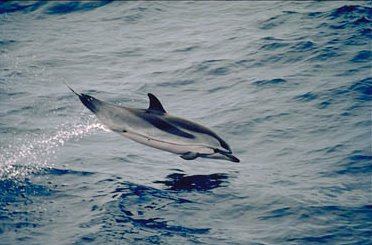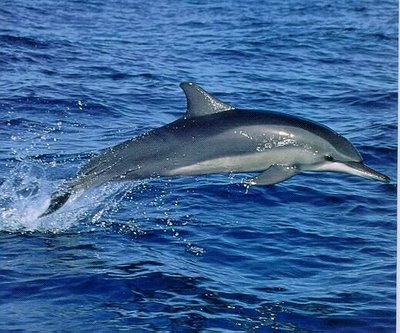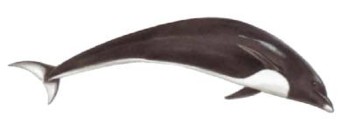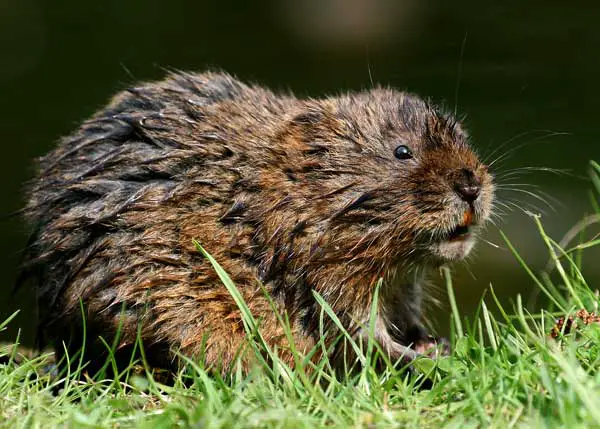Striped Dolphin
The Striped Dolphin can be found in the tropical and temperate waters of all of the oceans in the world. This dolphin species was first discovered in 1833 by Meyen. Its Latin name refers to the colours of its flanks, which are dark blue and white.
It is similar in size to other dolphins that inhabit these waters such as the Clymene Dolphin, Atlantic Spotted Dolphin, and the Pan-tropical Spotted Dolphin. However, its colouration does make it easy to distinguish them at sea. They have a whitish or pinkish underside. There are 1 or 2 black bands circling its eyes, and these run across to the back towards its flipper. As the name suggests, there are quite a number of stripes on this dolphin. These stripes are all either grey or light blue. Its appendages are all black. At birth, a Striped Dolphin will weigh about 10 kg and are 1 metre long. However, as adults they will grow up to 2.4 – 2.6 metres long and weigh between 150 – 160 kg.
Interestingly enough, research has found that Striped Dolphins in various sea waters will sexually mature at different ages. A Striped Dolphin in the Mediterranean Sea will take 12 years to mature, while those in the Pacific Ocean will take about 7 to 9 years to sexually mature. They will usually live up to about 55 to 60 years in the wild. Gestation lasts for about 1 year, but there is a 3 – 4 year gap between calving.
Similarly to other dolphins, the Striped Dolphin is a social creature and will therefore move in large groups. These groups are so large that they can be up to 1000s of individuals. However, it is thought that these groups could be smaller in the Atlantic Ocean and the Mediterranean Sea, and that they mix with Common Dolphins. They will eat small pelagic fish and squid.
Striped Dolphins are capable of performing acrobatics. They frequently breach and they jump far above the water’s surface. Sometimes they will approach boats in the Mediterranean Sea and the Atlantic Ocean, but this is less common in the Pacific Ocean where they were heavily exploited in the past.
Unfortunately, Japan hunted the Striped Dolphins in the western Pacific Ocean since at least the 1940s. During “striped dolphin drives”, 8000 – 9000 individuals were killed per year, except for one exceptional year where a whopping 21,000 individuals were killed. Since quotas were introduced in the 1980’s, this number has fallen to about 1000 kills per annum. However, Conservations are worried that the Striped Dolphin population in the Mediterranean Sea are threatened by disease, pollution, shipping lanes, and accidental catches.
There have been attempts to try and keep this dolphin in captivity. Unfortunately, the Striped Dolphin has failed live successfully in captivity, with animals usually dying within 2 weeks because they fail to eat.





oh look another one the japanese are killing off.
Thank You for Your Informative article on Striped Dolphins. Unfortunately, Many People are unaware of How the “Entertainment Dolphin”s are acquired. It has been a Dark Secret that is Just Now Reaching the Voice and Eyes of the Public.
For those who are still unaware, Dolphins do not do well in Captivity. Not just the Striped Ones… Captive Dolphins are Not Having Fun when People are Interacting with them in concrete pools or closed in spaces so unlike their natural environment. They have been trained to perform… Do not think that because they are “smiling” (which is actually not a smile but the permanent bone structure of their face making them look like they are smiling), they are happy.
Taiji Japan, is known for extreme measures in hunting dolphins in pods in large numbers, exterminating many and keeping only a few of the pretty ones to sell. Much of this Dolphin Horror Happens in “The Cove”… These Trained Dolphins are Greatly Traumatized having Seen Their Entire Family Slaughtered in the Death Run to the Cove, and their being kept in Small Unsanitary Tanks in Dolphin Base where they are Conditioned and Pre-Trained before Shipping out to the Inland Entertainment Aquariums..
And Significant Numbers of these Captured Dolphins Die before Shipping out to Entertainment Parks. So, Please, Promote Dolphin Interaction in the Wild and Help Get the Word Out about Dolphin Abuse! …
The authentic dolphin doesn’t live in a pool at Sea World, or any other marine park prison. If you want to have an encounter with one of these fascinating creatures….go to their home in the ocean. There you will find the authentic dolphin, living in his own environment. All you will see at a marine park is a human trained robot, a shell that man has forced himself on. Captivity is a joke! Don’t fool yourselves….it’s muti-billion dollar industry…it’s all about the almighty dollar. They don’t give a rip about these creatures at these places. If they cared they wouldn’t imprison them in cement pools filled with artificial sea water! Their main source of communication is through sophisticated sonar. Yet they live in cement enclosures. It bounces off the walls around them, driving them crazy. Hence-trainers getting killed. Does that sound familiar? They are trained to eat dead fish, yet in the wild they can travel up to 40 miles a day foraging for food. If they don’t perform, they don’t eat in alot of these places. These marine parks should be a thing of the past! They don’t belong in the 21st century! Go see them in the wild! Captivity susidizes the slaughters.
japan is cool but i dont like that theyre killing all these freaking see creatures . what the hell man. japan needs to calm down with theyre fish catching. is there anybody else who thinks so? gosh darnit’ leave the dolphins and whales alone ! go catch some dam pigs or something , we breed so many damn cows and pigs there such a GINORMOUS populations. im sure you can settle for that. DAMN YOU JAPAN!